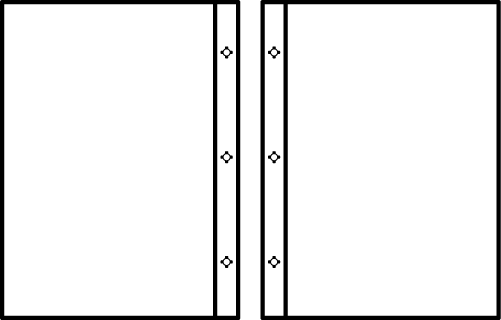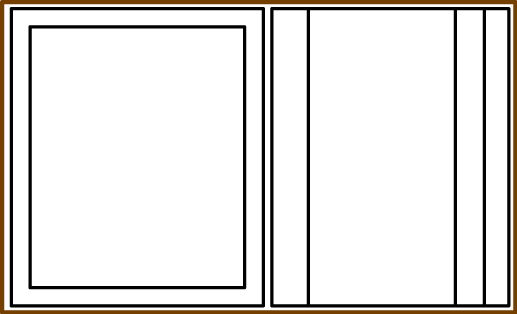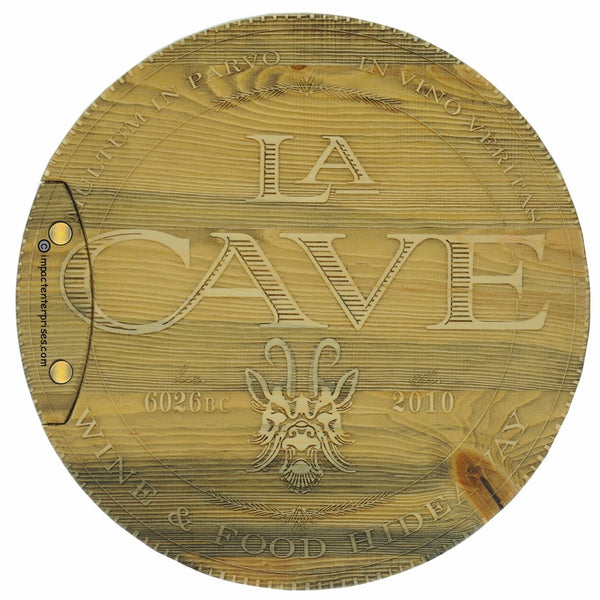FAQ's
General Questions
Can you provide a price list for Menu Covers and Binder Covers?
For our custom products we provide quotes with alternative options. Pricing is always dependent upon your particular specifications which can include a wide selection of options. In addition, Impact’s unique manufacturing capability will provide you with new specification options for consideration. A price list would be perplexing due to the number of options Impact can make available to you.
Your Impact Design Sales Associate will make specification suggestions for you in order to meet your product needs and budget requirements. Ask Questions… we are here to make certain you are comfortable with all available options that may be appropriate for your binder cover, menu cover, or other custom product.
Basic Menu Cover and Binder Cover Specification Options to consider for Pricing Estimates:
Size of Printed Insert your cover is to hold. This helps to determine the size of the cover that will be required.
Number of Printed Inserts your cover is to hold (number of views). This also helps to determine the size of the cover that will be required.
Type of Construction you prefer: turned-edge or heat-sealed (see Construction Options).
Cover Material you prefer: leather, wood, metal, poly, etc. ( see Cover Material Options).
Lining Material you prefer: fabric, faux leather, linen, etc. (see Lining Material Options).
Interior Features you prefer: pockets, pen loops, CD holders, etc. (see Interior Options).
Type of Binding you prefer: corner pockets, bar pockets, ring mechanisms (see Binding Options)
Type of Decoration you prefer: debossed, screened, engraved, etc. (see Decoration Options).
Quantity: number of pieces you may require.

What are the ordering requirements?
An order is processed upon receipt of confirmed specifications (purchase order), artwork, and your deposit.
Turn-around Time is approximately 4 – 6 weeks from the time your order is put into the production queue.
A rush order will be entertained depending upon scheduled delivery dates for orders in queue at the time. A rush fee will apply.
Minimum Quantity: 25 to 50 pieces depending upon the items and materials being requested. Quantities below this stated minimum will be entertained but may result in a higher cost per piece. The purpose of minimum quantities is to maintain competitive pricing for custom orders.
Do you offer discounts for larger quantitites?
Prices are quoted based on order quanity. Discounts are often available for larger quanities. Please contact us for a proposal based on your project specifications.
What choices should I consider when ordering Binder Covers and Menu Covers?
Accordion Style
A menu cover that typically has four or more narrow or 1/2 panels and multiple spines. This type of menu cover folds like an accordion. Common for Tapas food selections and wine lists.

Bar Pocket
See Horizontal Bar Pockets and Vertical Bar Pockets.
Bi-fold
A binder cover or menu cover that holds two or more printed inserts. It typically has a front cover, spine, and back cover.

Binding
The feature, assembly, or mechanism in a binder covers and menu covers that holds the printed inserts in the cover.
Corner Pockets
A binding feature for a menu cover. These are small triangle-shaped pockets that are secured to each corner of an interior panel. The four corners of the printed insert fit into these corner pockets and the insert is held in place.
Photo Corners - for all intensive purposes, the same as corner pockets.
Die-cut Bar Pockets
These are bar pockets that have a unique shape. they can be either horizontal die-cut bar pockets or vertical die-cut bar pockets. (See Horizontal Bar Pockets and Vertical Bar Pockets).

Gate-fold
A menu cover that has two 1/2 front panels that open like a gate. There are two spines - one on the left side and one on the right side. A gate-fold has three views - the two half interior panels (one on the right side and the other on the left side when the cover is opened) and one full interior panel (the center panel when the gate-fold is in the open position).

Half-panel
A panel in a menu cover that is half-sized - half the size of the primary panel(s).

Heat-sealed
See Construction - Heat-sealed. Heat-sealed construction uses a heat process to join the cover material to the lining material at the edge of the underlying board. The two materials are melted and blended at the edge of the board. Once cooled, the uneven edge created by the melting and blending is cut to make it even. The resulting edge is straight but slightly rough to the feel.
Horizontal Bar Pockets
A binding feature for menu covers. These are narrow horizontal pockets that are attached to the bottom edge and top edge of the interior panels. Usually ranging in height from 1/2" high to 1" high, and running the full width of the interior panel. The top edge and the bottom edge of the printed insert are placed into these pockets to hold the insert secure.

Horizontal Pockets
A pocket inside binder covers and menu covers that typically run the full width of the interior cover. Frequently Horizontal Pockets are used to hold a brochure, loose papers, etc. These are available in custom sizes.

Landscape
A binder cover and menu cover 'format' or orientation. Landscape format is wider than it is high.

Picture Frame Binding
A binding feature that literally frames the printed insert (like a picture frame). The frame is open on one side (usually the top or interior left side) and the printed insert in inserted into the opened side.

Pockets
A relatively standard feature inside binder covers and menu covers that is used to hold loose papers, brochures, business cards, etc. Pockets come in all sizes.
Portrait
Binder covers and menu covers orientation. Portrait format is higher than it is wide.

Post & Screw
A binding feature that secures multiple printed inserts using a screw-post assembly that is built into the spine of binder covers and menu covers. The posts are inserted into holes that have been drilled into the assembly and into the printed inserts, and then the screws are screwed into the posts, securely fastening the printed inserts.

Ring Mechanism
Another binding feature that secures multiple printed inserts. This is also known as a ring binder. The ring mechanism is secured to the interior spine or the interior back cover of the binder covers. The printed inserts which have been drilled with holes along the left edge are attached to the ring mechanism by opening (separating) the rings and inserting the inserts.

Secretary Pockets
A pocket inside binder covers and menu covers that is open on two sides. these are used for easy insertion and removal of brochures, loose papers, etc. Typically a secretary pocket will have a diagonally cut corner or a curved corner on the opened side.

Single-panel
A menu cover that holds a single printed insert.

Tri-fold
A menu cover that holds three printed inserts.

Turned-edge
See Construction - Turned-edge. Turned-edge construction wraps the cover material of the binder cover or menu cover over the edge of the board. The resulting edges are smooth, tight, and provide a nice clean appearance.
Two Piece Covers
A binder cover or menu cover that has a front cover that is separate from the back cover (two separate pieces). These are not permanently joined. The front cover and back cover are joined only when securing inserts into the binder cover. (A typical binder cover or menu cover has the front cover and back cover permanently joined).

Vertical Bar Pockets
Similar to Horizontal Bar Pockets, except these pockets have a vertical orientation and are attached to the right and left edges of the interior panels.The right and left edge of the printed insert are placed onto these pockets to hold the insert secure.

Vertical Pockets
A pocket inside the binder cover or menu cover that typically runs the full height (from top to bottom) of the interior panel. Frequently Vertical Pockets are used to hold the back cover of a brochure or spiral bound booklet so that the pages are free to be turned and viewed. This is a creative design for holding a multiple page insert.

Views
The total number of sides of inserts with print. If an insert has print on both sides then it has two views. Example: If a bi-fold menu cover holds only two inserts than that menu cover offers two views because the inserts have print only on one side. If the same menu cover had two center-leaf panels then that menu cover could offer six views.
What Binder Cover and Menu Cover options are available?
‘Fixed’ Material Construction
'Fixed’ Material is a term that we use to describe a binder cover or menu cover material that consists of a single material. Solid wood is an example, as is solid metal, Plexiglas, tempered glass, uncovered chipboard, etc. The cover consists of a single uncovered material. Typically, these will be manufactured using a quarterbind spine, however, Impact has developed several new designs which provide alternatives to a quarterbind spine.
Impact is the foremost manufacturer of solid wood menu covers and binder covers. We are also the first to use tempered glass in our binder cover and menu cover designs. We offer all in unique shapes.

Heat-sealed Construction
A more economical menu cover and binder cover construction, particularly for large quantity orders. Essentially, the cover material and lining material are typically both vinyl, and are joined at the edge of the rigid underlying board (substrate) by a heat process that melts and blends them together at the edge . Once cooled, the uneven edge is cut straight, but does leave an edge that is somewhat rough to the touch. It is this ‘rough’ edge that makes “Heat-sealed’ products somewhat less ‘upscale’, HOWEVER, we have produced many beautiful and uniquely designed menu covers and binder covers using heat-sealed construction.
Impact’s choice of heat-sealable materials is extensive. We offer faux leathers in many different textures and colors, and can offer many of the design features that we have available for Turned-edge construction. Heat-sealed menu covers and binder covers have become quite sophisticated in appearance and design.

Turned-edge Construction
Long considered to be the more upscale type of construction, Turned-edge requires a minimum of two materials to create a binder cover or menu cover: a rigid material and a flexible or supple material that is turned over the edges of the rigid material. Thus the name turned-edge. The supple material (your cover material choice) covers one side of the rigid material as it wraps over the edges and around to the back side of the rigid material. The resulting edges are smooth and continuous and provide a nice clean appearance.
The rigid material is frequently called substrate, or underlying board. It can be chipboard, plastic, metal, or some other material.
The cover material is the finish material. It can be one of many different materials such as leather, faux leather, thin metals, linen, other fabrics, vinyl, paper, urethane, etc.
The lining material can be the same as the cover material or one of many other different materials
A unique Impact feature is that we can use multiple cover materials in turned-edge construction when creating a binder cover or menu cover. We are the first to ‘marry’, or join, two or more cover materials to create unique, eye-catching, and branding quality designs for our binder covers and menu covers. If you would like two or more lining materials joined also…, just ask Impact.

Cover Materials
Impact’s material options are incredibly varied. Our unique manufacturing capabilities allow us to work with materials never used before in the binder cover and menu cover manufacturing process. This allows us to continually research new materials which make the list of materials available for our menu covers and binder covers a dynamic and ever growing list. We strive to continue to provide new materials that stir excitement, adventure, and creativity into the manufacturing industry for custom menu covers, custom binder covers, and other custom products. Ask your Impact Design Sales Associate for your cover material preferences and colors if you do not see them listed.
A summary list of materials include:
Genuine Leathers in a wide selection of textures, colors, and grades
Faux Leathers in urethane, vinyl, and other materials also in an incredibly wide selection of textures, colors, and grades. Our faux leathers are considered to be the best available.
Copper[1]
Brass
Brushed Aluminum[2]
Silver
Solid Woods from Verified Sustainable Forests (all types of woods are available)
Polyethylene and Polypropylene in a wide selection of thicknesses, colors and finishes
Acrylic and Plexiglas in a wide selection of colors and thicknesses.
Vinyl (the vinyl list like our urethane list is almost endless)
Tempered Glass
Solid Metals
Fabrics from around the world
Paper
Lining Materials
Lining material options for binder covers and menu covers are even more varied than the cover material options. All cover material options are available as lining materials for a binder cover or menu cover, plus there are lighter weight materials available for lining material that are not appropriate for a cover material. So the list just continues to grow.
Impact has swatch cards and sample swatches for thousands of materials, both cover and lining materials. After brief conversation with your Impact Design Sales Associate, she or he will be able to present you with options that are appropriate for you to consider. We are an authority in the field of materials for binder covers and menu covers. We will work with you to make certain you have a cover and lining material that creates the binder cover or menu cover that you truly desire.
[1] Our Copper and Brass finishes are available in a wide selection of unique and exclusive natural organic patina finishes.
[2] Our Brushed Aluminum is available in a wide selection of patterns and with antiqued finishes if desired.
Interior Options
See Interior Options.
Decorations Options
See Decorations Options.
Ring Specifications
See Ring Mechanisms.
Sample Font Selections
